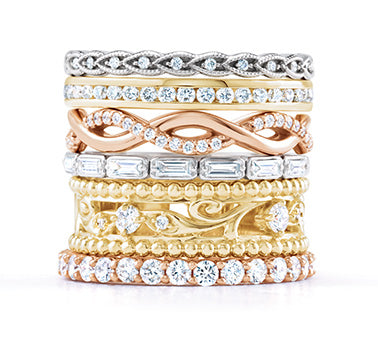Lifetime Warranty
24/7 Hour Customer Service
Free Shipping
30-Day Return
Moijey Fine Jewelry & Diamonds Blog
Aquamarine: Crystallized Seawater
Originally posted on March 9th, 2017
Revised on March 26th, 2020
The name for the beloved gemstone, aquamarine, is translated from Latin. aquamarine means "water from the sea," aqua meaning "water" and marina, meaning "the sea."
Aquamarine is a variety of the gem species beryl, which is also related to emerald. While emerald acquires its lustrous green from chromium and vanadium, aquamarine obtains its reputable blue hue from traces of iron in its crystal structure. It is standard practice in the gem and jewelry industry to have aquamarine heat-treated to remove any greenish color and reveal a cleaner shade of blue.
For thousands of years, aquamarine has – and still is – enjoying a reputation of being a soothing and protective stone. The most popular folklore surrounds sailors and their belief that aquamarine talismans, usually carved with the sea god Neptune's image, will provide safe voyages at sea.
Aquamarine is also credited for providing inner tranquility and helps the wearer become calm and level-headed. Traditionally, aquamarine was a gift for the nineteenth wedding anniversary, and it is said to enhance happiness in a marriage.
Not only is this stone for people born from February 19th to March 20th, but this gemstone can also be a gift for everyone. Aquamarine's greenish-blue hue complements every skin tone, and it is excellent with all kinds of precious metals. It can look regal in yellow gold or fresh and modern in either sterling silver or white gold. There's also a subtle romance when crisp aquamarine complements the warmth of rose gold.
Aquamarine crystals form in a rock called pegmatite, which develops from cooling, once-molten granite. The granite contains rare and necessary chemicals to produce aquamarine. As the last of the molten granite cools in its surrounding rock, the different chemicals will separate themselves from the granite and attach themselves to the edge of the surrounding pegmatite. The aquamarine crystals form in the fractures, therefore becoming deposits for miners.
The most valuable and productive aquamarine mine is in Minas Gerais, Brazil. Since 1811, the veins in the northeast region of Minas Gerais have been in producing beautiful quantities of aquamarine.
It began when a miner found a large aquamarine crystal that weighed up to fifteen pounds, the first of many tremendous minerals to be recorded in the history of the mine. In 1910, miners discovered the most prominent crystal to date, and it weighed over 240 pounds! The gem itself was so transparent that people were able to read newspaper text through it! Pictured below is an excellent example of what comes from Minas Gerais. This crystal calls the Smithsonian Museum of Natural History home.

Not only is aquamarine found in pegmatites, but the crystals can also found in river beds. Many gems, historically, have been found in river beds or have been dug out of the ground by independent miners called garimpeiros. Now mechanized strip mining is the chosen recovery method for aquamarine crystals.
Pakistan is also another source of aquamarine. There are multiple mines at high elevations, and miners often have to cut into the sides of cliffs. Most miners have to climb as high as fifteen thousand feet! The mines produce light greenish-blue to blue crystals that can measure up to twelve inches by five inches. The gem pictured below (from the Smithsonian website) are lovely examples from Pakistan, and now it resides in the Smithsonian.

China is relatively new in aquamarine production. The country has recently become a leading producer in small, commercial-quality crystals. The stones, after faceting, are widely used in mass-market jewelry. They become readily available on home shopping networks and other high-volume outlets. Unfortunately, the mining techniques are not as refined as other mines in the world. As a result, the gem-quality yield – which is pale in color and has little to no inclusions - is between ten percent and fifteen percent.
Recently, Vietnam has discovered aquamarine sources with well-formed crystals that possess an attractive shade of greenish-blue.
Lesser-known sources of Aquamarine are Madagascar, Mozambique, Nigeria, Kenya, Zambia, Australia, and the United States. At the Smithsonian, there is a piece of aquamarine (pictured below) mined in New Hampshire, and it weighs 1,430 pounds.
You read that correctly, one thousand four hundred and thirty pounds! It is one of the multiple and equally impressive pieces of aquamarine on display at the Smithsonian.
We hope you enjoyed this updated article about the glories of aquamarine. Stop by our site anytime to learn more about what we can offer!
Aquamarine: Crystallized Seawater
Originally posted on March 9th, 2017
Revised on March 26th, 2020
The name for the beloved gemstone, aquamarine, is translated from Latin. aquamarine means "water from the sea," aqua meaning "water" and marina, meaning "the sea."
Aquamarine is a variety of the gem species beryl, which is also related to emerald. While emerald acquires its lustrous green from chromium and vanadium, aquamarine obtains its reputable blue hue from traces of iron in its crystal structure. It is standard practice in the gem and jewelry industry to have aquamarine heat-treated to remove any greenish color and reveal a cleaner shade of blue.
For thousands of years, aquamarine has – and still is – enjoying a reputation of being a soothing and protective stone. The most popular folklore surrounds sailors and their belief that aquamarine talismans, usually carved with the sea god Neptune's image, will provide safe voyages at sea.
Aquamarine is also credited for providing inner tranquility and helps the wearer become calm and level-headed. Traditionally, aquamarine was a gift for the nineteenth wedding anniversary, and it is said to enhance happiness in a marriage.
Not only is this stone for people born from February 19th to March 20th, but this gemstone can also be a gift for everyone. Aquamarine's greenish-blue hue complements every skin tone, and it is excellent with all kinds of precious metals. It can look regal in yellow gold or fresh and modern in either sterling silver or white gold. There's also a subtle romance when crisp aquamarine complements the warmth of rose gold.
Aquamarine crystals form in a rock called pegmatite, which develops from cooling, once-molten granite. The granite contains rare and necessary chemicals to produce aquamarine. As the last of the molten granite cools in its surrounding rock, the different chemicals will separate themselves from the granite and attach themselves to the edge of the surrounding pegmatite. The aquamarine crystals form in the fractures, therefore becoming deposits for miners.
The most valuable and productive aquamarine mine is in Minas Gerais, Brazil. Since 1811, the veins in the northeast region of Minas Gerais have been in producing beautiful quantities of aquamarine.
It began when a miner found a large aquamarine crystal that weighed up to fifteen pounds, the first of many tremendous minerals to be recorded in the history of the mine. In 1910, miners discovered the most prominent crystal to date, and it weighed over 240 pounds! The gem itself was so transparent that people were able to read newspaper text through it! Pictured below is an excellent example of what comes from Minas Gerais. This crystal calls the Smithsonian Museum of Natural History home.

Not only is aquamarine found in pegmatites, but the crystals can also found in river beds. Many gems, historically, have been found in river beds or have been dug out of the ground by independent miners called garimpeiros. Now mechanized strip mining is the chosen recovery method for aquamarine crystals.
Pakistan is also another source of aquamarine. There are multiple mines at high elevations, and miners often have to cut into the sides of cliffs. Most miners have to climb as high as fifteen thousand feet! The mines produce light greenish-blue to blue crystals that can measure up to twelve inches by five inches. The gem pictured below (from the Smithsonian website) are lovely examples from Pakistan, and now it resides in the Smithsonian.

China is relatively new in aquamarine production. The country has recently become a leading producer in small, commercial-quality crystals. The stones, after faceting, are widely used in mass-market jewelry. They become readily available on home shopping networks and other high-volume outlets. Unfortunately, the mining techniques are not as refined as other mines in the world. As a result, the gem-quality yield – which is pale in color and has little to no inclusions - is between ten percent and fifteen percent.
Recently, Vietnam has discovered aquamarine sources with well-formed crystals that possess an attractive shade of greenish-blue.
Lesser-known sources of Aquamarine are Madagascar, Mozambique, Nigeria, Kenya, Zambia, Australia, and the United States. At the Smithsonian, there is a piece of aquamarine (pictured below) mined in New Hampshire, and it weighs 1,430 pounds.
You read that correctly, one thousand four hundred and thirty pounds! It is one of the multiple and equally impressive pieces of aquamarine on display at the Smithsonian.
We hope you enjoyed this updated article about the glories of aquamarine. Stop by our site anytime to learn more about what we can offer!






